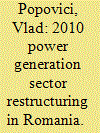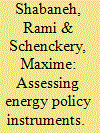|
|
|
Sort Order |
|
|
|
Items / Page
|
|
|
|
|
|
|
| Srl | Item |
| 1 |
ID:
103527


|
|
|
|
|
| Publication |
2011.
|
| Summary/Abstract |
In the spring of 2009, the Romanian government has proposed a restructuring of the national power generation sector segment that is still owned by the state. As most of the power generation capacity is still state-owned, this restructuring will dramatically alter the competitive landscape of this sector. This paper is analyzing the rationale and principles of the restructuring as stated by government documents and officials, the assessment methodology and criteria proposed by the government, as well as the proposed final outcome of the restructuring initiative. Based on this critical assessment and the early results of the restructuring's implementation, we are able to make recommendations that can be considered for a revised restructuring approach.
|
|
|
|
|
|
|
|
|
|
|
|
|
|
|
|
| 2 |
ID:
150829


|
|
|
|
|
| Summary/Abstract |
This paper uses air pollution emissions data for the years 2002, 2005, 2008, and 2011 to estimate monetary damages due to air pollution exposure for PM2.5, SO2, NOx, NH3, and VOC from electric power generation, oil and gas extraction, coal mining, and oil refineries. In 2011, damages associated with emissions from these sectors totaled 131 billion dollars (in 2000$), with SO2 emissions from power generation being the largest contributors to social damages. Further, damages have decreased significantly since 2002, even as energy production increased, suggesting that, among other factors, policies that have driven reductions in emissions have reduced damages. The results of this analysis highlight the spatial heterogeneity of the impacts associated with the emissions of a given pollutant. In the past, environmental regulations have assumed that the benefits of air emissions reductions are homogenous across source location. This analysis suggests that policy designs that account for spatial differences in the impacts of air emissions could result in more effective environmental regulation. Accounting for such spatial heterogeneity in the benefits of policies would be akin to accounting for differences in compliances costs across states, which the EPA did when establishing the state emissions standards for the Clean Power Plan rule.
|
|
|
|
|
|
|
|
|
|
|
|
|
|
|
|
| 3 |
ID:
171377


|
|
|
|
|
| Summary/Abstract |
Saudi Arabia relies heavily on oil-based generation to meet its power needs within a geographically unbalanced pattern of natural demand and supply. Many initiatives are currently being assessed to reduce the high opportunity cost of burning oil for the country. This paper examines the cost and implication of a disruptive policy where Saudi Arabia imports liquefied natural gas (LNG). To determine the possible and optimal sources to procure LNG into Saudi Arabia we use and configure a partial equilibrium model, specified as a linear programming problem. Two import scenarios were tested: the first assumes an import terminal with a capacity of 5 million tonnes per annum (MTPA) and the other scenario assumes 22 MTPA. Results show that Saudi Arabia can import LNG for power generation at a discount to the opportunity cost of oil. Especially during the summer months, as Saudi Arabia's gas demand is counter-seasonal to major importing regions it leads to even more interesting market pricing conditions. It also shows a small difference in landed cost of LNG between the two scenarios which implies the global LNG market can accommodate relatively large demand from Saudi Arabia without distorting significantly the global market pricing mechanism.
|
|
|
|
|
|
|
|
|
|
|
|
|
|
|
|
| 4 |
ID:
116912


|
|
|
|
|
| Publication |
2012.
|
| Summary/Abstract |
This work presents the development situation of biomass gasification power generation technology in China and analyzes the difficulty and challenge in the development process. For China, a large agricultural country with abundant biomass resources, the utilization of biomass gasification power generation technology is of special importance, because it can contribute to the electricity structure diversification under the present coal-dominant electricity structure, ameliorate the environmental impact, provide energy to electricity-scarce regions and solve the problems facing agriculture. Up to now, China has developed biomass gasification power generation plants of different types and scales, including simple gas engine-based power generation systems with capacity from several kW to 3 MW and integrated gasification combined cycle systems with capacity of more than 5 MW. In recent years, due to the rising cost of biomass material, transportation, manpower, etc., the final cost of biomass power generation has increased greatly, resulting in a serious challenge in the Chinese electricity market even under present preferential policy for biomass power price. However, biomass gasification power generation technology is generally in accord with the characteristics of biomass resources in China, has relatively good adaptability and viability, and so has good prospect in China in the future.
|
|
|
|
|
|
|
|
|
|
|
|
|
|
|
|
| 5 |
ID:
112249


|
|
|
|
|
| Publication |
2012.
|
| Summary/Abstract |
Despite three decades of reform, the electric power industry in China is still organised by a partial reformed plan system, where the investment to build capacity has been liberalised, but the prices and the production remain controlled by the state. This paper examines the pricing behaviour of the power supply in China, where the state attempts to balance the interest between the public and the electric power industry. The empirical evidence shows that the cost factors are critical to the electricity pricing in China, and that the bargaining mechanism, which sets the plan price, allows the power producers to face a soft budget constraint on their own costs.
|
|
|
|
|
|
|
|
|
|
|
|
|
|
|
|
| 6 |
ID:
094882


|
|
|
|
|
| Publication |
2010.
|
| Summary/Abstract |
Chinese coal consumption continues to rise as the country's economy and industry expand. Coal is particularly critical for China's fast-growing power sector, generating about 80% of electricity output. Notwithstanding the importance of coal and electricity, many international forecasts today underestimate their rising use in China. This paper acknowledges the current world financial crisis and assumes that Chinese GDP growth to 2025 will not again approach double-digit levels. Using the scenario analysis, this paper demonstrates that even with conservative assumptions about Chinese GDP growth and income elasticity of electric demand to 2025, the country will likely experience much higher coal demand and emit much greater volumes of carbon dioxide than forecast by various international energy agencies. The paper also analyzes how China's domestic coal reserves may be threatened within two decades, possibly affecting long-term economic growth in China, as well as world coal prices.
|
|
|
|
|
|
|
|
|
|
|
|
|
|
|
|
| 7 |
ID:
112900


|
|
|
|
|
| Publication |
2012.
|
| Summary/Abstract |
In this paper, we develop a methodology for deriving a consistent measure for supply adequacy in the power generation sector. We especially consider the secured generation capacity of intermittent renewable energy sources such as wind. Availability of conventional power plants is estimated through stochastic convolution of unscheduled non-usabilities. We employ our methodology to measure supply security in Germany until 2030. A detailed market analysis of power plants that are currently being built or planned provides support to our analysis for the short term. For the long term, we rely on a large-scale dispatch and investment model of the European power sector to account for the embedding of the German electricity sector in the European market. We analyze two scenarios: one with prolongation of nuclear power plants and one with a nuclear phase-out. Our results show that, even though intermittent renewables only provide very limited secured generation capacity, security of electricity supply in Germany can be assured until 2015. In the long term, the need for backup capacity for renewable energy sources increases as well as the need for electricity imports.
|
|
|
|
|
|
|
|
|
|
|
|
|
|
|
|
| 8 |
ID:
109672


|
|
|
|
|
| Publication |
2011.
|
| Summary/Abstract |
Even as small island developing states (SIDS) like Trinidad and Tobago (T&T) increase industrialization and grapple with the challenges of increased pollution, few studies provide guidance to policy makers of such countries on appropriate policy measures and instruments that can be implemented to mitigate greenhouse gas emissions. Here we apply a multi-criteria evaluation methodology to ascertain preferences for policy measures and instruments in the power generation sector. Four broad policy measures and twelve policy instruments are assessed on criteria of environmental performance, feasibility of implementation and political acceptability. This method proves useful in T&T, since typical to many SIDS, the intensive data required by other policy assessment methods is unavailable. Results indicate little difference in preference among the four policy measures thereby indicating that a multi-pronged approach on several policy fronts is required. The most preferred policy instruments to operationalize measures included provision of subsidies for energy saving technologies, creating an industry wide carbon trading scheme and implementing a feed-in tariff to increase the use of renewable energy sources. This study therefore provides specific insights for policy makers in Trinidad and Tobago while also providing power generation sector specific guidance to other rapidly industrializing small island developing states.
|
|
|
|
|
|
|
|
|
|
|
|
|
|
|
|
| 9 |
ID:
104934


|
|
|
|
|
| Publication |
2011.
|
| Summary/Abstract |
With the introduction of market-oriented measures in China's power sector in the mid-1980s, electricity sale prices to the grid companies-on-grid electricity tariffs-became the focus of the energy industry, thus affecting all related stakeholders, including fuel suppliers, power generators and end-use consumers. A number of changes have gradually been undertaken in terms of electricity tariff settings and their implementation to address specific requirements of the expansion of the power industry at each stage of its development. On-grid electricity tariffs had been used as a key lever to attract investment in power generation at an early stage of reform and then to encourage competition in the power industry. In response to the rising concerns about environmental protection and the promotion of clean energy utilisation, tariffs have progressively been developed for renewable electricity generation, which has contributed to massive expansion of the renewable power industry in China. This paper reviews key milestones of the development of on-grid electricity tariffs in China, examines the tariff-setting mechanisms of coal-fired power plants and renewable power generation, analyses the factors associated with the adjustments of the tariff levels and discusses the options for further reform and more effective electricity pricing.
|
|
|
|
|
|
|
|
|
|
|
|
|
|
|
|
| 10 |
ID:
177146


|
|
|
|
|
| Summary/Abstract |
Nuclear is considered as a valuable option for the decarbonization of power generation, as it is a no-carbon, yet commercially consolidated technology. However, its real prospects are uncertain, especially in the OECD countries. The main aim of this work is to explore the techno-economic implications of policy-relevant scenarios for nuclear power, designed on the actual prospects in the world regions and developed with the Integrated Assessment Model WITCH.
|
|
|
|
|
|
|
|
|
|
|
|
|
|
|
|
| 11 |
ID:
150454


|
|
|
|
|
| Summary/Abstract |
The utilization of agricultural biomass for production of electric power can help to reduce the environmental emissions while achieving energy security and sustainable development. This paper presents a methodology for estimating the power production potential of agricultural biomass in a country. Further, the methodology has been applied to develop a roadmap for producing reliable power in India. The present study reveals that about 650 Mt/year of agricultural biomass is generated in India, while about one-third of this has been found to be surplus for energy applications. The cereal crops have major contribution (64.60%) in production of surplus biomass followed by sugarcane (24.60%) and cotton (10.68%). The energy potential of these resources is of the order of 3.72 EJ, which represents a significant proportion of the primary energy consumption in the country. These biomass resources can produce electric power of 23–35 GW depending upon the efficiency of thermal conversion. The delivery of biomass to the plants and selection of appropriate technology have been found as the major issues that need to be resolved carefully. In the end, the study summarizes various technological options for biomass collection and utilization that can be used for producing clean and consistent power supply.
|
|
|
|
|
|
|
|
|
|
|
|
|
|
|
|
| 12 |
ID:
112315


|
|
|
|
|
| Publication |
2012.
|
| Summary/Abstract |
The present research study used the quantitative approach to analyze the present and future situation of the Venezuelan power generation sector; to achieve that, the total energy generation costs and GHG emissions of four scenarios in 2050 were estimated and compared, considering two demand groups, high and low demand. For each demand scenario, two supply matrix were considered, a generation matrix based on the existing national power generation plans and trends (these scenarios were referred as BAU) and a configuration based on the renewable energy resources available in Venezuela and without the use of either nuclear or CCS technologies, and these scenarios are referred as Sustainable Scenarios (SUS). In the first section, the present situation is presented, followed by an explanation of the applied methodology and the implemented tools. In the third and fourth sections the available recourses and the applied basic assumptions for the four of scenarios are presented and discussed, respectively, followed by the results. In this study it is shown that Venezuela has all the resources it needs to achieve sustainable development in the power generation sector. It is also proved that an energy efficiency improvement is the easiest path to reduce GHG emissions.
|
|
|
|
|
|
|
|
|
|
|
|
|
|
|
|
| 13 |
ID:
150919


|
|
|
|
|
| Summary/Abstract |
Studying temporal patterns in emissions associated with electricity generation is increasingly important. On the supply side, there is interest in integrating renewable energy sources (solar, wind), which are known to vary daily and hourly. On the demand side, the concept of demand response is driving a need to better understand the impact of peak versus off-peak loading, with the objective of maximizing efficiency. In this study, we examine the case of electric power generation in Singapore, and aim to assess the half-hourly variation in associated average carbon dioxide emissions. Given the country’s serious push for clean energy solutions and a possibility of adopting carbon trading in the future, we feel the need to address the currently existing gap in research on daily CO2 emissions patterns. By associating representative electricity generation data with the characterized fleet of power plants, half-hourly emissions are found to range between 415 and 455 kg CO2 per MW h. Marginal emission factors show a fluctuating daily pattern between 390 and 800 kg CO2/MW h. Policy makers able to work with real generation data can use this approach to understand the carbon footprint of short-term supply and demand interventions.
|
|
|
|
|
|
|
|
|
|
|
|
|
|
|
|
| 14 |
ID:
095841


|
|
|
|
|
|
|
|